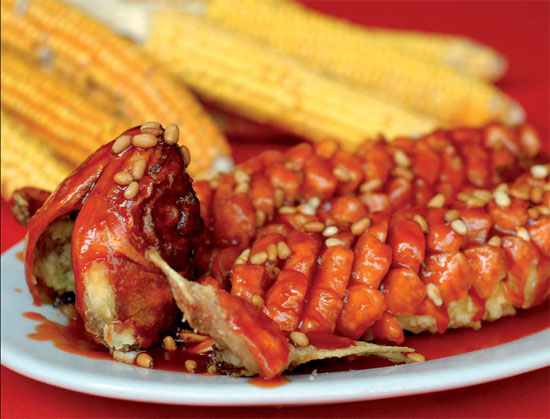Fishing for a fortune
Updated: 2013-01-11 07:20
By Juling He (何菊玲) (China Daily)
|
||||||||
|
Songshuyu, or Squirrel Fish, is one of the most popular dishes during Spring Festival in North China. Zhang Xiangyang / For China Daily |
Food is a meaningful part of chinese new year celebrations
A fish dish is an indispensible part of every Chinese family's New Year's Eve feast. It's practically a tradition in rural areas for wizened grandmothers to stalk the dining room table, shooing children away with the warning, "Don't touch the fish! Otherwise, we won't be blessed with good fortune next year!"
In China, fish and fortune are finely intertwined, as illustrated by the hengpi (横批, horizontal scrolls) bearing the couplet 年年有余 (nián nián yǒu yú, have surplus year after year) that are pasted over doors during Spring Festival.
The door itself or adjoining wall may also be emblazoned with paper-cuts carrying the same inscription, as well as pictures of a golden carp carried by a chunky little chap of unknown origin.
The association with good fortune is extended further by the fact that 余 (yú, surplus food and money) and 鱼 (yú, fish) are homonyms, helping elevate the fish to a kind of Spring Festival good luck mascot.
Back in the mists of time, 鱼 was also a synonym for "letter". In ancient China, people often wrote letters on silk and concealed them in carp stomachs as a means of delivering information in secret. This was known as 鱼传尺素 (yú chuán chǐ sù, using a fish to deliver messages).
This now long defunct practice was the primary influence on the later habit of folding letters wishing health and good wishes to friends and loved ones into a double-carp shape before mailing them.
Moreover, in the Tang (AD 618-907) and Song (960-1279) dynasties, noble lords wore fish-shaped talismans 鱼符 (yú fú, fish-shaped talismans) as a means of showcasing their wealth and nobility, while Buddhist monks and laity still use a wooden fish (木鱼 mùyú) drum to keep tempo while chanting sutras. Fish are also traditionally one of the sacrifices necessary to properly perform the rituals associated with worshiping one's ancestors.
While most of these traditions have fallen by the wayside, their resonance can still be felt through the hallowed status accorded to the fish dish every New Year's Eve. In North China, one of the most popular dishes during Spring Festival is Squirrel Fish (松鼠鱼, sōngshǔyú).
This quirky dish is essentially a tribute to sweet and sour. In the grand Chinese tradition of naming food after strange things they look like, Squirrel Fish is so named because of the crosshatch technique used to cut into the fish flesh, which after being deep-fried opens up the body and positions the head and tail like a jaunty squirrel. The whole fish is deboned before frying to give it further lift.
Freshwater fish such as yellow croaker, carp and Mandarin fish, also known as the Osmanthus fish (桂鱼 guìyú), are the most commonly used bases for the dish.
Legend has it that during Emperor Qianlong's extensive tour of the south, he caught sight of a particularly frisky carp and, delighted by its apparent zest for life, ordered it to be cooked immediately. In an attempt to capture the fish's former joie de vivre, the chef focused on giving it a reanimated-look when he fried it.
Others say that the origin of the dish's name lies in the squirrel-like squeaks and squeals that erupt from the flesh when hot sauce is poured over it.
The dark brown fried fish is crisp on the outside and tender and yielding on the inside, and as "moreish" on the palette as any deep-fried delight.
However, it's the sauce that makes or breaks a good Squirrel Fish - it should be sufficiently piquant, singingly sweet and sour enough to titillate even regal taste buds. Often served in a retina-damaging shade of orange in restaurants, a home-made squirrel fish should be a little more subtle and elegant, in keeping with its royal heritage.
Courtesy of The World of Chinese, www.theworldofchinese.com
The World of Chinese
(China Daily 01/11/2013 page19)

 Li Na on Time cover, makes influential 100 list
Li Na on Time cover, makes influential 100 list
 FBI releases photos of 2 Boston bombings suspects
FBI releases photos of 2 Boston bombings suspects
 World's wackiest hairstyles
World's wackiest hairstyles
 Sandstorms strike Northwest China
Sandstorms strike Northwest China
 Never-seen photos of Madonna on display
Never-seen photos of Madonna on display
 H7N9 outbreak linked to waterfowl migration
H7N9 outbreak linked to waterfowl migration
 Dozens feared dead in Texas plant blast
Dozens feared dead in Texas plant blast
 Venezuelan court rules out manual votes counting
Venezuelan court rules out manual votes counting
Most Viewed
Editor's Picks

|

|

|

|

|

|
Today's Top News
Boston bombing suspect reported cornered on boat
7.0-magnitude quake hits Sichuan
Cross-talk artist helps to spread the word
'Green' awareness levels drop in Beijing
Palace Museum spruces up
First couple on Time's list of most influential
H7N9 flu transmission studied
Trading channels 'need to broaden'
US Weekly

|

|









